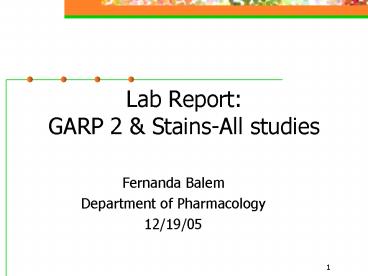Lab Report: GARP 2 PowerPoint PPT Presentation
Title: Lab Report: GARP 2
1
Lab ReportGARP 2 Stains-All studies
- Fernanda Balem
- Department of Pharmacology
- 12/19/05
2
Aim
- ? To investigate if Stains all dye could be used
to explore the conformations of GARP-protein.
3
Stains all
? Metachromatic cationic carbocyanine dye
Stains-all (1-ethyl-2-3-(1-ethyl-naphthol1,2-d
thiazoline-2-ylidine)-2-methylpropenyl ? It
can bind to highly acidic proteins . ? It can
also be used to distinguish calcium-binding
proteins (CaBP) from others. CaBP are stained
blue or purple by Stains-all while others
proteins are stained red or pink
4
Spectrum in ethylene glycol
All the further experiments were conducted in 30
ethylene glycol .
5
Interaction of Calmodulin with Stains-all
A- visible spectrum of Calmodulin with Stains all
complexes with 2mM MOPS,30 ethylene glycol,pH
7.2. The dye-Calmodulin mole ratios are Control,
50, 25, 12.5, 6.25, 3.12, 1.56 and 1
respectively. B- Shows the difference spectra
from Stains all/Calmodulin. C- Prominent peaks of
difference spectra.
6
Interaction of Calmodulin CaCl2 with Stains-all
A- visible spectrum of Calmodulin CaCl2 with
Stains all complexes with 2mM MOPS,30 ethylene
glycol, pH 7.2. The dye-CAlmodulin mole ratios
are Control, 50, 25, 12.5, 6.25, 3.12, 1.56 and 1
respectively. B- Shows the difference spectra
from Stains all/Calmodulin CaCl2. C- Prominent
peaks of difference spectra.
7
Spectra of Stains-all in different concentrations
of Ethylene Glycol
The spectra was checked with 200mM Mops. 15
210 320 430 540 650 760 870
980 1090 and 11100.
Dye concentration is 5µM.
Dye concentration is 10µM.
Dye concentration is 20µM
Dye concentration is 15µM.
8
Dye/protein ratio 150 225 312.5 46.25
53.12 61.56 71 80.
9
Spectra of Stains-all Calmodulin
- Fig A Shows the spectra of dye/protein ratio of
12.5. This was performed with fresh Stains-all. - Fig B Shows the spectra of dye/protein ratio
12.5. Stains-all used was 1 week old. Dye
concentration is 20µM and Protein 1.6µM.
A
B
10
Time course experiment to find the minimum time
required for interaction of protein with stains
all, we looked at increase in absorbance at 650nm
, as this band is induced by the resulting
interaction.
11
- From our previous experiments, we conclude that
dye/protein ratio of 12.5 is optimal to induce
the 650nm band.In order to make this experiment
work for less concentration of protein, different
concentration of stains all was tried keeping the
ration of dye/protein 12.5 - The experiment showed that 20µM dye is the
minimum concentration, where we can induce the
650nm band. For that we decided carry out all
further experiments with a dye concentration of
20µM.
12
The experiments stopped working as the stains-all
might have got illuminated. So, We started the
experiment with new stains all and the results
looks different.
- Ratio dye/protein 250 325 412.5
56.25 63.12 71.15 and 81. - The 650nm band is induced at 1.15 dye/protein
ratio instead of 12.5 observed in previous
experiments.
13
Future plans
- We plan to investigate about the interaction of
Garp-2 with stains all dye to help us understand
if this dye could be used as a system to find
different conformation of the Garp-2 protein. - We are trying to find optimum buffer conditions
to concentrate Garp-2 for NMR studies.
14
Acknowledgements
- Dr. Judith
- Harpreet
- David
15
Thank you very much for your attention!

